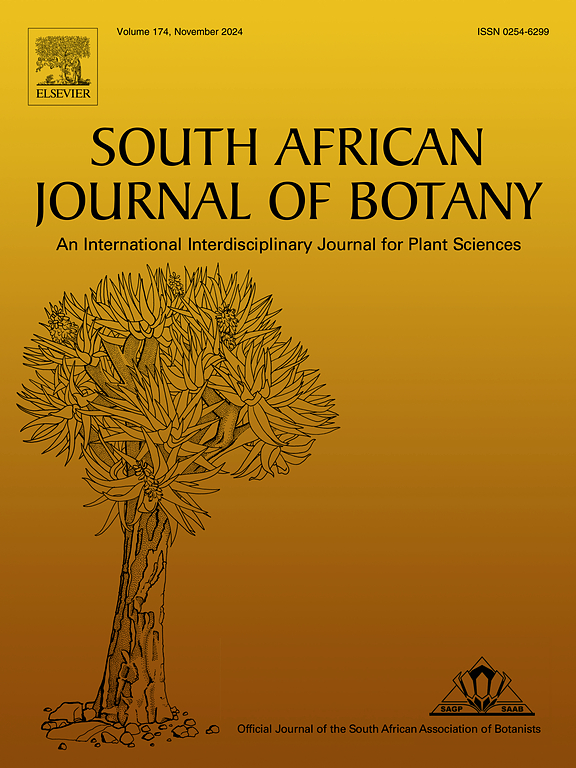Identification of PFN2 as an Epimedii Folium flavonoid brain target by mass spectrometry in conjunction with DRATS
IF 2.7
3区 生物学
Q2 PLANT SCIENCES
引用次数: 0
Abstract
Epimeriid Folium (EF), a traditional and commonly used Chinese medicinal herb, is known to have effects on attenuating cognitive deficits in neurogenerative diseases. As the main bioactive component of EF, flavonoids’ protein targets have not been fully understood. Moreover, no comprehensive examination of flavonoid-related protein targets in mild cognitive impairment (MCI)—a state that falls between dementia and normal aging—has been documented. In this study, a laser confocal inverted microscope was utilized to localize flavonoids in the leaf tissue of Epimedium brevicornu Maxim. species. UPLC-Triple TOF-MS and UPLC-QTRAP-MS was performed to qualitatively and quantitatively identify the flavonoids in EF. The candidate protein targets of EF flavonoids (EFF) in brain tissues were identified by liquid chromatography-mass spectrometry-based drug affinity responsive target stability (MS-DARTS). The shared targets of MS-DARTS and databases were conducted GO and KEGG analysis. Finally, molecular docking and biolayer interferometry (BLI) was used to preliminary validate the potential targets. Results showed that flavonoids were mainly distributed in the collenchyma and epidermal cells. EFF was analyzed, revealing that 22 compounds accounted for 88.54 % of the EF extract. The primary compounds identified were icariin (28.32 %) and icariside II (27.27 %). A total of 67 flavonoid-related protein targets were found by MS-DARTS, of which 45 overlapped with databases for MCI. Profilin 2(PFN2) was found exclusively in the EFF group and was observed at the maximum abundance. Molecular docking and BLI demonstrated a strong interaction between PFN2 and the primary compounds, suggesting that PFN2 is a target for the main component, icariside II. Taken together, our research uncovered the components and possible targets of EFF, highlighting PFN2 as a promising therapeutic target for EFF. This discovery enables us to address cognitive decline in clinical environments and establishes a basis for further studies on other traditional Chinese medicinal substances.
质谱联用DRATS技术鉴定淫羊藿类黄酮脑靶蛋白PFN2
表艾草叶(EF)是一种传统的常用中草药,具有减轻神经变性疾病认知缺陷的作用。黄酮类化合物作为黄芪的主要生物活性成分,其蛋白作用靶点尚未完全了解。此外,在轻度认知障碍(MCI)——一种介于痴呆和正常衰老之间的状态——中,还没有对类黄酮相关蛋白靶点的全面检查。本研究利用激光共聚焦倒置显微镜对淫羊藿叶组织中的黄酮类化合物进行了定位。物种。采用UPLC-Triple TOF-MS和UPLC-QTRAP-MS对黄酮类化合物进行定性和定量鉴定。采用液相色谱-质谱联用技术(ms - dart)对脑组织中EF类黄酮(EFF)的候选蛋白靶点进行了鉴定。ms - dart和数据库共享目标进行GO和KEGG分析。最后,利用分子对接和生物层干涉法(BLI)对潜在靶点进行初步验证。结果表明,黄酮类化合物主要分布在厚壁细胞和表皮细胞中。对EFF进行分析,发现22种化合物占提取物的88.54%。主要化合物为淫羊藿苷(28.32%)和淫羊藿苷II(27.27%)。ms - dart共发现67个黄酮类相关蛋白靶点,其中45个与MCI数据库重叠。Profilin 2(PFN2)仅在EFF组中发现,丰度最高。分子对接和BLI表明PFN2与主要化合物之间存在强烈的相互作用,表明PFN2是主要成分icariside II的靶标。综上所述,我们的研究揭示了EFF的成分和可能的靶点,强调了PFN2是EFF的一个有希望的治疗靶点。这一发现使我们能够解决临床环境中的认知衰退问题,并为进一步研究其他中药材奠定基础。
本文章由计算机程序翻译,如有差异,请以英文原文为准。
求助全文
约1分钟内获得全文
求助全文
来源期刊

South African Journal of Botany
生物-植物科学
CiteScore
5.20
自引率
9.70%
发文量
709
审稿时长
61 days
期刊介绍:
The South African Journal of Botany publishes original papers that deal with the classification, biodiversity, morphology, physiology, molecular biology, ecology, biotechnology, ethnobotany and other botanically related aspects of species that are of importance to southern Africa. Manuscripts dealing with significant new findings on other species of the world and general botanical principles will also be considered and are encouraged.
 求助内容:
求助内容: 应助结果提醒方式:
应助结果提醒方式:


